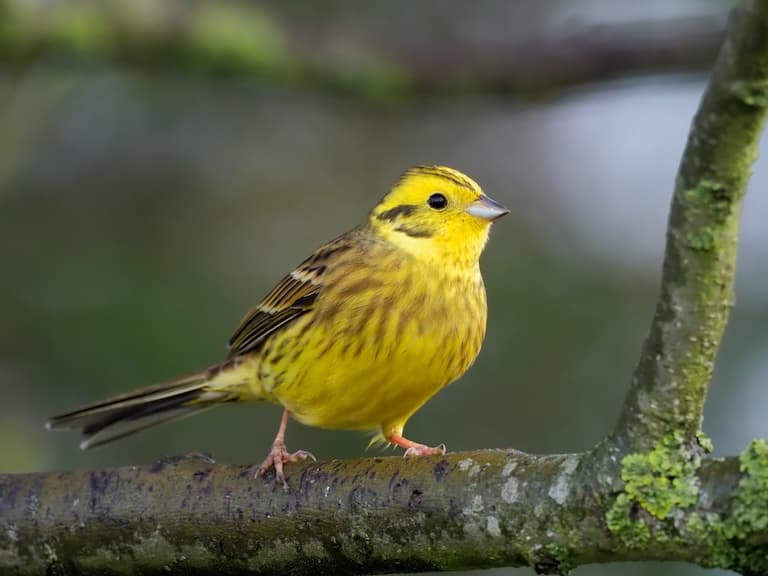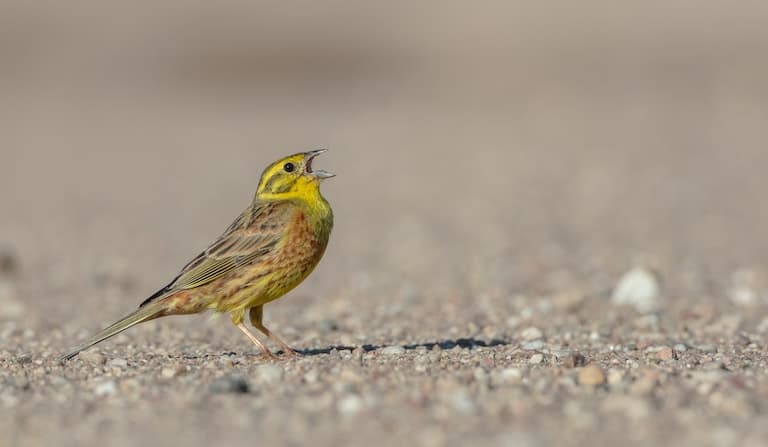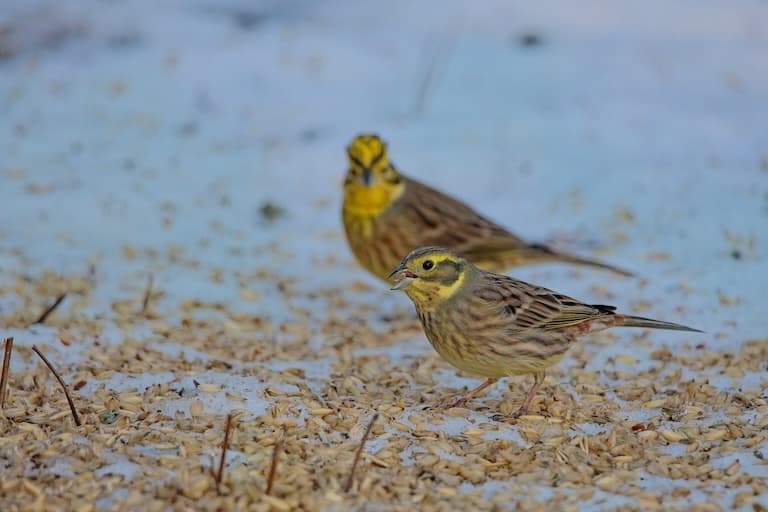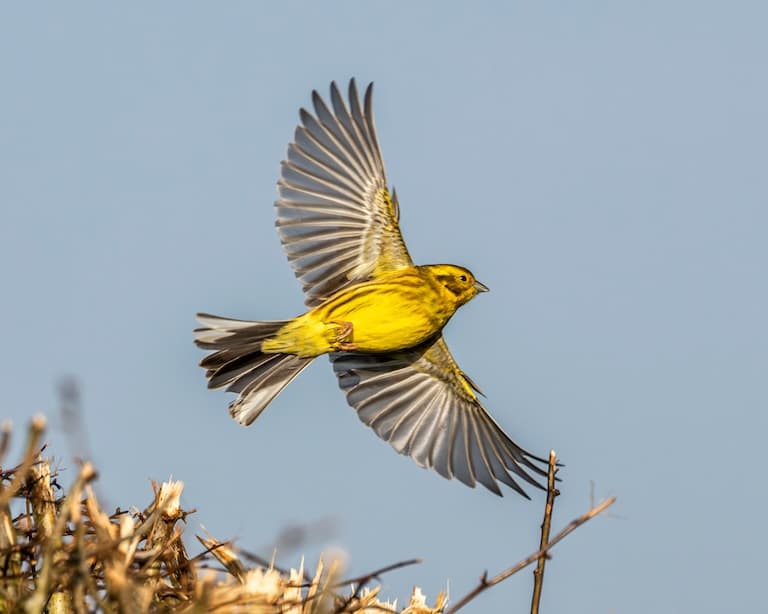Yellowhammer Profile
Whether you recognise the name or not, chances are good that the first four notes of Beethoven’s Fifth Symphony are immediately familiar, and it’s very likely that you can thank a small yellow bird for this.
Because the original composer of those notes is said to have been the Yellowhammer, a pretty little songbird from Europe, whose role in the farmland ecosystems of the 18th century is really only starting to be understood today.

Yellowhammer Facts Overview
| Habitat: | Transitional zones between woodland and open country |
| Location: | Eurasia, New Zealand and Australia |
| Lifespan: | Usually around 3 years, but up to 13 |
| Size: | 16–16.5 cm (6.3–6.5 in) long |
| Weight: | Unknown |
| Color: | Bright yellow head and breast, streaked brown back, chestnut rump |
| Diet: | Mostly seeds, some invertebrates |
| Predators: | Corvids, raptors, rodents |
| Top Speed: | Unknown |
| No. of Species: | 1 |
| Conservation Status: | Least Concern |
The yellowhammer is a small and very charismatic songbird from Europe that is instantly recognisable in both appearance and song, and as a member of the buntings, they are finch-like seed eaters, with a long history on the continent.
So much so, that they have found their way into classical works of music and literature.
They, along with 43% of all bird species in the UK, are about to disappear completely, but thankfully, the British populations make up a small fraction of what’s left on the mainland.
Interesting Yellowhammer Facts
1. They’re buntings
Yellowhammers are the type species for the Bunting family, which are a group of Old World birds closely related to the New World blackbirds, cardnials and American sparrows.
Unlike the majority of this group, they’re more firmly rooted in Eurasia, though some have found success after being introduced into New Zealand and Australia, too.
They’re one of the largest and prettiest members of their genus, which is quite an honour, considering the company they keep.

2. They’re hedgerow specialists
Yellowhammers live in the unique combination habitats between woodland and open country, and there is nothing in Europe that matches this transitional space as well as the old-style hedgerows between farmland.
Being seed-eaters, they’re probably not too popular among the cereal growers on the continent, but as we’ll come back to shortly, they should be, because this species and many like them are critical to the health of the wild and cultivated lands we rely on.
3. They inspired Beethoven
Europe in the 1700s had some pretty extreme class divides. In those days, only the very wealthy had access to instruments, which were hand made and far rarer than they are now.
One such family was the Beethovens, who, admittedly became much poorer around the time of the famous composer, but were still not living on bread and cheese when Ludwig himself composed his Fifth Symphony, the infamous first four notes being widely regarded as a dramatic tribute to this little bird’s song.
Some go as far as to include other works like Beethoven’s Concerto No. 4, which is more of a gentle nod to birdsong in general and could also have been inspired by the yellowhammer.
Of course, not everyone had the time to imagine symphonies and concertos in the 1700s, most were lucky enough to get some bread.

4. “A little bit of bread and no cheese”.
As if in tribute to Europe’s grotty and impoverished history of 18th Century peasantry, the lasting interpretation of this little bird’s call from the other end of the social ladder is still said to be the phrase “A little bit of bread and no cheese”.
This is a far humbler interpretation of the sound, but certainly not quite as artistic as a piano concerto.
Beatrix Potter was the first to write it down, much later in 1911, in the Tale of Timmy Tiptoes, and Enid Blyton repeated it in the 1940s.
So, it’s clear that this little farm bird struck a chord in the hearts of Europeans for centuries, and so it’s sad that it’s in such decline.
5. It’s on the red list.
Between 1967 and 2023, there was a 66% decline in Yellowhammer numbers in the UK. It’s one of Britain’s 19 native bird species that are used in the UK Farmland Bird Indicator – a measure of the health of native bird populations, and it’s not doing very well there at all.
This is because of its specialisation in the transitional habitats between woodland and open country, in conjunction with Britain’s relentless separation and reduction of both of these1.
Britain has been on a steady and rapid push top Easter Island itself for a while now, but thankfully for animals like the Yellowhammer, the rest of Europe is accelerating slightly slower in this direction.
6. But they’re still fine over all
Yellowhammers on the mainland are in decline as well, but given that there’s a lot more space there – and a lot of it is better managed – they’re not even close to threatened yet.
In fact, there are up to 90 million breeding individuals across the Yellowhammer’s range, so it should take a while to make a significant dent in their populations2.

7. They could make a comeback in the UK
Ironically, the bird that calls for a “Little bit of Bread and no Cheese” has been pushed out of the country in place of intensive cereal and dairy production.
But across Europe, the intensifying nature of modern farming has seen landscapes stamped by vast swathes of uninterrupted crop substrates. In the olden days, these stamps would not only have been smaller, but also demarcated by rows of hedge, planted as a clear barrier, but occupied by innumerable local wildlife species.
As intensive farming seems to be reaching its plateau – and possibly its impending decline – in terms of production, new drives to bring back these hedgerow ecosystems are gaining traction as a way of improving biodiversity and therefore soil health and productivity.
The Yellowhammer, as a hedgerow species would be one of the many animals to bounce back if the UK could adopt such practices, as would the general health of the plants and animals supported by them3.
8. They’re significant contributors
Yellowhammers are true fighters, and are faced with a wealth of danger from multiple predators. In fact, over 60% of reproductive failure for this species comes as a result of predation from nest-raiding corvids and rodents, or from raptors like sparrowhawks and eagles.
This sounds like a rough time, but from an ecological standpoint this makes the Yellowhammer very important as a food source for all of these species, and their success therefore supports the trophic tiers above them, as well as putting pressure on those levels beneath them, too.
As a seed-eater, the dispersal effect of their messy eating habits supports the plants they feed on, supporting gene flow between populations and, of course fertilising the soil with the recycled seeds they consume.
All in all, this is one of many species that while inspiring to our artists, is far more significant as a wild ecosystem engineer.
Yellowhammer Fact-File Summary
Scientific Classification
| Kingdom: | Animalia |
| Phylum: | Chordata |
| Class: | Aves |
| Order: | Passeriformes |
| Family: | Emberizidae |
| Genus: | Emberiza |
| Species Name: | Cirtinella |
Fact Sources & References
- (2024), “Wild Bird Indicators for the UK”, BTO.
- (2024), “Yellowhammer”, The IUCN Red List of Threatened Species in 2024.
- Anne Marshall-Chalmers (2023), “The Edges Matter: Hedgerows Are Bringing Life Back to Farms”, Civil Eats.
